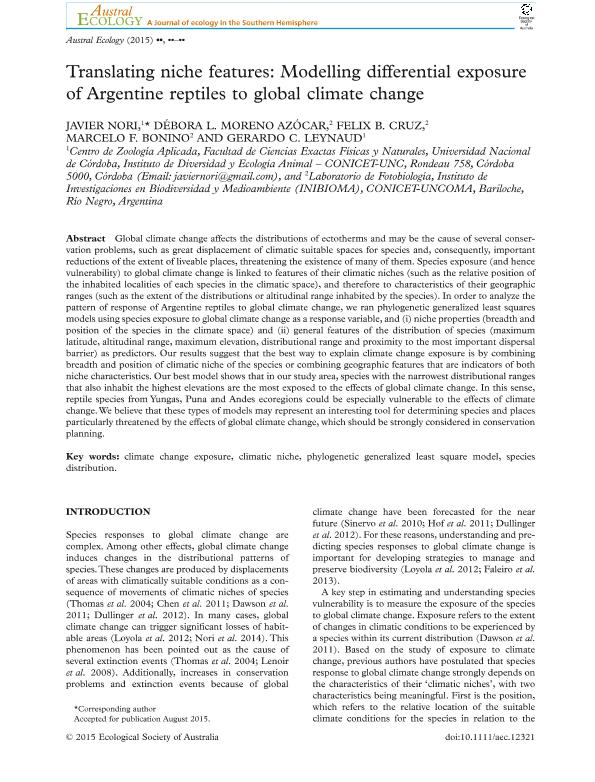Mostrar el registro sencillo del ítem
dc.contributor.author
Nori, Javier
dc.contributor.author
Moreno Azócar, Débora Lina

dc.contributor.author
Cruz, Felix Benjamin

dc.contributor.author
Bonino, Marcelo Fabián

dc.contributor.author
Leynaud, Gerardo Cristhian

dc.date.available
2016-11-04T17:50:26Z
dc.date.issued
2015-08
dc.identifier.citation
Nori, Javier; Moreno Azócar, Débora Lina; Cruz, Felix Benjamin; Bonino, Marcelo Fabián; Leynaud, Gerardo Cristhian; Translating Niche Features: Modeling Differential Exposure of Argentine Reptiles to Global Climate Change; Wiley; Austral Ecology; 41; 4; 8-2015; 367-375
dc.identifier.issn
1442-9985
dc.identifier.uri
http://hdl.handle.net/11336/7994
dc.description.abstract
Global climate change affects the distributions of ectotherms and may be the cause of several conservation problems, such as great displacement of climatic suitable spaces for species and, consequently, important reductions of the Extent of liveable places, threatening the existence of many of them. Species exposure (and hence vulnerability) to global climate change is linked to features of their climatic niches (such as the relative position of the inhabited localities of each species in the climatic space), and therefore to characteristics of their geographic ranges (such as the extent of the distributions or altitudinal range inhabited by the species). In order to analyze the pattern of response of Argentine reptiles to global climate change, we ran phylogenetic generalized least squares models using species exposure to global climate change as a response variable, and (i) niche properties (breadth and position of the species in the climate space) and (ii) general features of the distribution of species (maximum latitude, altitudinal range, maximum elevation, distributional range and proximity to the most important dispersalbarrier) as predictors. Our results suggest that the best way to explain climate change exposure is by combining breadth and position of climatic niche of the species or combining geographic features that are indicators of both niche characteristics. Our best model shows that in our study area, species with the narrowest distributional ranges that also inhabit the highest elevations are the most exposed to the effects of global climate change. In this sense, reptile species from Yungas, Puna and Andes ecoregions could be especially vulnerable to the effects of climate change.We believe that these types of models may epresent an interesting tool for determining species and places particularly threatened by the effects of global climate change, which should be strongly considered in conservation planning.
dc.format
application/pdf
dc.language.iso
eng
dc.publisher
Wiley

dc.rights
info:eu-repo/semantics/openAccess
dc.rights.uri
https://creativecommons.org/licenses/by-nc-sa/2.5/ar/
dc.subject
Climate Change
dc.subject
Climatic Niche
dc.subject
Phylogenetic Model
dc.subject
Distribution
dc.subject.classification
Ecología

dc.subject.classification
Ciencias Biológicas

dc.subject.classification
CIENCIAS NATURALES Y EXACTAS

dc.title
Translating Niche Features: Modeling Differential Exposure of Argentine Reptiles to Global Climate Change
dc.type
info:eu-repo/semantics/article
dc.type
info:ar-repo/semantics/artículo
dc.type
info:eu-repo/semantics/publishedVersion
dc.date.updated
2016-11-02T18:12:42Z
dc.journal.volume
41
dc.journal.number
4
dc.journal.pagination
367-375
dc.journal.pais
Reino Unido

dc.journal.ciudad
Londres
dc.description.fil
Fil: Nori, Javier. Universidad Nacional de Cordoba. Facultad de Cs.exactas Fisicas y Naturales. Centro de Zoologia Aplicada; Argentina
dc.description.fil
Fil: Moreno Azócar, Débora Lina. Consejo Nacional de Investigaciones Científicas y Técnicas. Centro Científico Tecnológico Patagonia Norte. Instituto de Investigación En Biodiversidad y Medioambiente; Argentina
dc.description.fil
Fil: Cruz, Felix Benjamin. Consejo Nacional de Investigaciones Científicas y Técnicas. Centro Científico Tecnológico Patagonia Norte. Instituto de Investigación En Biodiversidad y Medioambiente; Argentina
dc.description.fil
Fil: Bonino, Marcelo Fabián. Consejo Nacional de Investigaciones Científicas y Técnicas. Centro Científico Tecnológico Patagonia Norte. Instituto de Investigación En Biodiversidad y Medioambiente; Argentina
dc.description.fil
Fil: Leynaud, Gerardo Cristhian. Consejo Nacional de Investigaciones Cientificas y Tecnicas. Centro Cientifico Tecnologico Cordoba. Instituto de Diversidad y Ecologia Animal; Argentina. Universidad Nacional de Cordoba. Facultad de Cs.exactas Fisicas y Naturales. Centro de Zoologia Aplicada; Argentina
dc.journal.title
Austral Ecology

dc.relation.alternativeid
info:eu-repo/semantics/altIdentifier/url/http://onlinelibrary.wiley.com/doi/10.1111/aec.12321/abstract
dc.relation.alternativeid
info:eu-repo/semantics/altIdentifier/doi/http://dx.doi.org/10.1111/aec.12321
Archivos asociados
